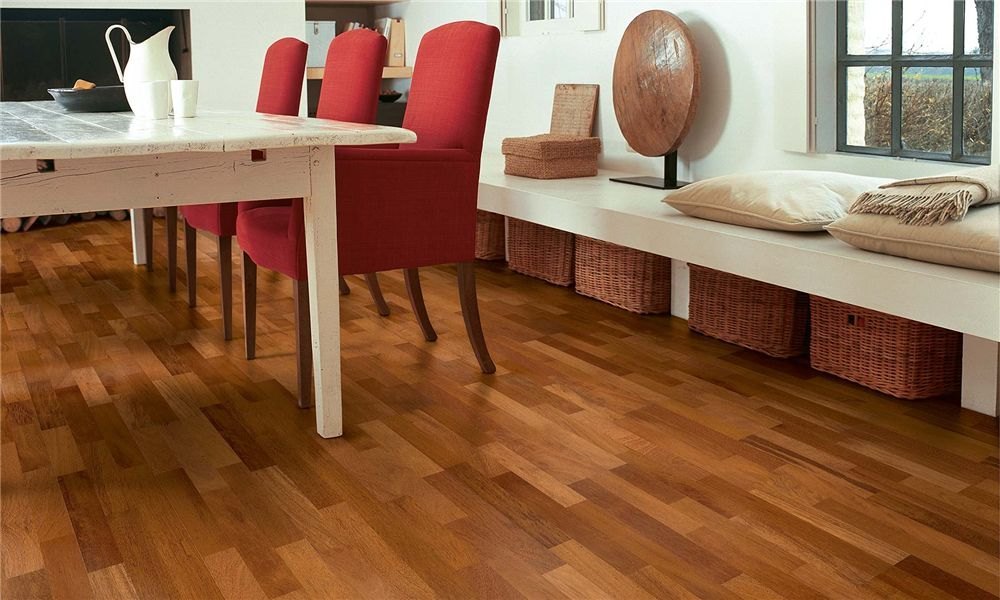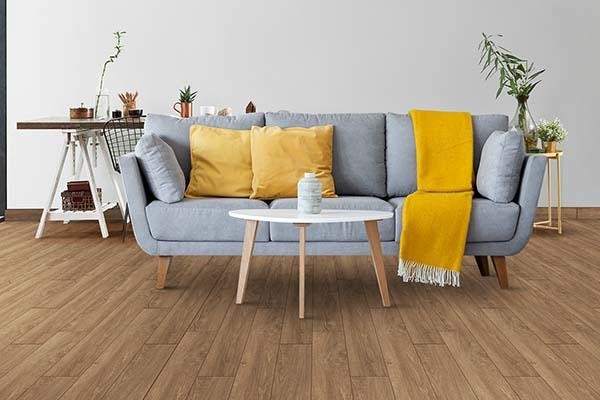
Shaping Room Acoustics in Spaces: The Role Flooring Plays
When designing a space, most people focus on aesthetics, comfort, and durability when choosing flooring. However, flooring plays a crucial role in shaping room acoustics, affecting how sound waves travel, reflect, or get absorbed. In a well-designed space, the right flooring can enhance sound clarity, minimize noise disruptions, and create an overall more pleasant acoustic environment.
Without the right flooring, sound can bounce uncontrollably, leading to excessive reverberation or sound transmission between rooms. Whether it’s footsteps echoing in an open-concept home, the persistent hum of conversations in an office, or unwanted vibrations in a recording studio, flooring choices directly impact how sound behaves in any given environment.
Why Room Acoustics Matter for Comfort, Productivity, and Sound Quality
Acoustics shape how we experience a space. In homes, poor acoustics can result in excessive noise transmission between rooms, making it difficult to relax. In offices, excessive reverberation can create a chaotic, distracting environment, reducing productivity. In studios, improper flooring can distort sound quality, affecting the clarity of recordings and performances.
The right flooring choices can help reduce unwanted echoes, prevent sound leakage, and create environments that are acoustically balanced, ensuring comfort, efficiency, and improved sound quality.
No two spaces require the same acoustic treatment. The flooring that works for a quiet home library may not be suitable for an open-plan office or a high-performance recording studio. The key is to understand how different materials affect sound and choose flooring that aligns with the primary function of the space.
The Relationship between Flooring and Acoustics
Sound moves in waves, bouncing off hard surfaces and being absorbed by soft materials. Flooring, in particular, affects both airborne noise (voices, music, television) and impact noise (footsteps, furniture movement). The wrong flooring can amplify sound and create disruptive echoes, while the right flooring can reduce noise levels and improve acoustic clarity.
There are two main types of noise affected by flooring:
- Airborne noise – Sounds like voices, music, or TV audio that travel through the air.
- Impact noise – Sounds generated by direct contact with the floor, such as footsteps, dragging furniture, or dropped objects.
The right flooring choice can minimize impact noise and manage airborne noise, creating a more balanced auditory experience. Additionally, each flooring material influences sound in one of three ways:
- Absorption: Materials like carpet and cork absorb sound waves, reducing echoes and improving sound clarity.
- Reflection: Hard surfaces like tile and hardwood reflect sound, often leading to excessive reverberation.
- Transmission: Some materials allow sound to pass through them, affecting rooms below or adjacent spaces.
Rooms with excessive hard surfaces tend to sound hollow and harsh, while spaces with ample soft materials feel quieter and more controlled. Flooring is a major factor in determining whether a space will sound bright and echoey or muted and balanced.
How Flooring Affects Acoustics in Different Spaces

- Open-concept homes. Open layouts amplify noise due to the lack of walls to break up sound waves. Hard flooring like tile or hardwood can create excessive echoes, making conversations feel overwhelming. Upstairs foot traffic can be disruptive. Using carpet, cork, or soundproofing underlays can reduce noise transfer between floors. For spaces designed around entertainment, carpet, acoustic underlayment, or specialized vinyl can improve sound insulation and clarity.
- Office acoustics. Busy offices are filled with background chatter, ringing phones, and constant movement. Flooring with sound-absorbing properties helps reduce distractions and increase focus. A completely hard-surfaced office can lead to excessive sound reflections, making it difficult to hear conversations clearly. Soft flooring elements like carpet tiles or rubber flooring help absorb sound while maintaining a professional look. In meeting spaces, excessive reverberation can make discussions difficult. Strategic use of low-pile carpet or cork flooring ensures speech intelligibility and privacy.
- Studio Acousticd. Studios need flooring that prevents vibrations and excess reverberation while maintaining sound clarity. Hardwood floors can provide a natural, warm sound but often require rugs to control reflections. Rubber or cork can help absorb unwanted vibrations. For professional studios, floating floors with rubber underlays are ideal for preventing sound transmission.
Comparing Flooring Materials and Their Acoustic Properties
The choice of flooring significantly influences how sound behaves within a space. Each flooring material has its own unique impact on echo, reverberation, impact noise, and overall sound clarity. Understanding these differences is key to selecting the right flooring for your home, office, or studio.
Hardwood Flooring:
Hardwood flooring is highly coveted for its timeless elegance, durability, and natural warmth. It adds value to homes and provides a sleek, polished aesthetic. However, when it comes to acoustics, hardwood can be challenging.
- Highly Reflective Surface – Hardwood floors do not absorb sound well. Instead, they reflect sound waves, which can increase echoes and reverberation, especially in large or sparsely furnished rooms. This can make conversations sound harsh and distant.
- Susceptible to Footstep and Impact Noise – Hardwoods can amplify footstep sounds, causing noticeable creaks and thuds, particularly in multi-story homes and offices with heavy foot traffic.
- Best Practices for Noise Reduction – To mitigate sound issues, hardwood flooring should be paired with soft furnishings such as area rugs, fabric-upholstered furniture, and heavy drapes. Using acoustic underlayment beneath hardwood planks can also help dampen noise transmission to rooms below.
Best for: Formal living rooms, dining areas, and bedrooms where style takes precedence over acoustic performance.
Carpet Flooring:
Carpet is one of the best flooring choices for sound absorption, making it an ideal option for noise-sensitive spaces. Its soft, fibrous texture acts as a natural barrier against airborne and impact noise, helping create a quiet, comfortable environment.
- Absorbs Airborne Noise – Unlike hard surfaces, carpet traps sound waves, preventing them from bouncing around a room. This enhances speech clarity and reduces unwanted echoes, making it an excellent choice for bedrooms, libraries, and offices.
- Reduces Impact Noise – Walking on carpet produces significantly less noise than hardwood or tile. This is especially beneficial in multi-story homes, apartment buildings, and workplaces where sound insulation is a priority.
- Available in Different Thicknesses for Enhanced Acoustic Benefits – Thicker carpets, particularly those with dense padding, provide superior sound absorption. Certain carpets are also designed with built-in soundproofing properties, making them particularly useful for home theaters and recording studios.
Best for: Bedrooms, home theaters, offices, and spaces where noise reduction is a top priority.
Tile and Stone Flooring:
Tile and stone flooring exude luxury, durability, and timeless appeal, making them a popular choice in kitchens, bathrooms, and entryways. However, from an acoustic perspective, these materials present some challenges.
- Highly Reflective and Amplifies Sound – Tile and stone have extremely hard, non-porous surfaces, causing sound waves to bounce repeatedly. This can increase noise levels, create echoes, and make spaces feel louder than intended.
- Cold and Hollow Sound Quality – Compared to wood or carpet, tile and stone floors can make a space sound hollow and stark. In large areas with high ceilings, such as open-plan kitchens and hallways, this effect is even more pronounced.
- How to Reduce Sound Issues – Adding area rugs, thick curtains, and upholstered furniture helps absorb sound and reduce unwanted reflections. Acoustic ceiling panels or wall treatments can also help counteract excessive reverberation.
Best for: Kitchens, bathrooms, hallways, and entryways where durability and easy maintenance are priorities but require added soft elements to balance acoustics.
Laminate and Vinyl Flooring:
Laminate and vinyl flooring have become increasingly popular as cost-effective alternatives to hardwood. These materials provide stylish aesthetics while offering better acoustic control than tile or stone.
- Some Laminate and Vinyl Options Come with Soundproofing Features – High-quality varieties include built-in acoustic underlays that help absorb sound and reduce footstep noise.
- Reduces Impact Noise Compared to Hardwood and Tile – While laminate and vinyl are still hard surfaces, they are generally quieter underfoot than tile or stone.
- Customizable Acoustic Enhancements – Additional underlayments or area rugs can further improve noise control, making these materials a good middle-ground option for homes and offices needing a balance between style and acoustics.
Best for: Homes, offices, and multi-functional spaces where cost, durability, and moderate acoustic performance are required.
Cork Flooring:
Cork flooring is one of the best flooring options for acoustic control, offering both natural sound absorption and eco-friendly benefits.
- Exceptional Sound Absorption – Cork contains millions of microscopic air pockets that trap sound waves, reducing both airborne noise and impact noise. This makes it an excellent choice for apartments, condos, and offices where noise control is a concern.
- Soft and Comfortable Underfoot – Unlike tile or hardwood, cork flooring provides a cushioned surface that minimizes the sound of footsteps, making it ideal for bedrooms and workspaces.
- Sustainable and Eco-Friendly – Harvested from the bark of cork trees without harming them, cork flooring is a renewable resource that supports green building practices.
Best for: Apartments, offices, eco-conscious homes, and spaces where soundproofing and sustainability are priorities.
Rubber Flooring:
Rubber flooring is a top performer in impact noise reduction, making it ideal for high-traffic and high-impact spaces.
- Superior Sound-Dampening Properties – Rubber absorbs vibrations, footsteps, and dropped objects, significantly reducing impact noise. This makes it a top choice for gyms, studios, and workspaces where sound insulation is essential.
- Highly Durable and Low Maintenance – Rubber flooring is resistant to wear, water, and heavy foot traffic, making it a long-lasting solution for commercial and residential applications.
- Ideal for Recording Studios and Performance Spaces – Because it absorbs vibrations, rubber flooring is often used in professional music studios, dance studios, and theaters to prevent unwanted sound transmission.
Best for: Gyms, studios, workspaces, and commercial areas where noise reduction and durability are key concerns.
Conclusion
Flooring is more than just a surface to walk on—it is a key element in shaping acoustics and creating a comfortable environment. Whether in homes, offices, or studios, choosing the right flooring can make all the difference in reducing noise, enhancing clarity, and improving overall sound quality. By balancing aesthetics, function, and acoustic performance, you can create spaces that sound as good as they look.
